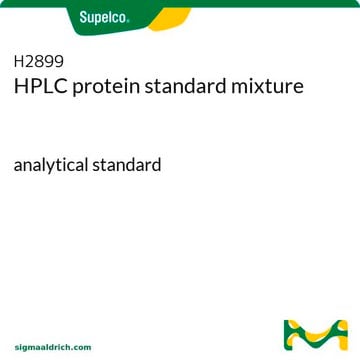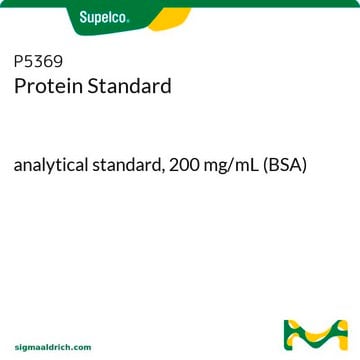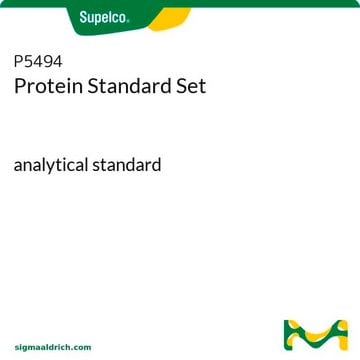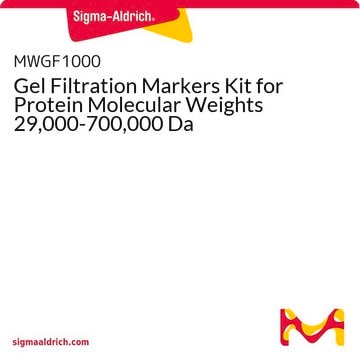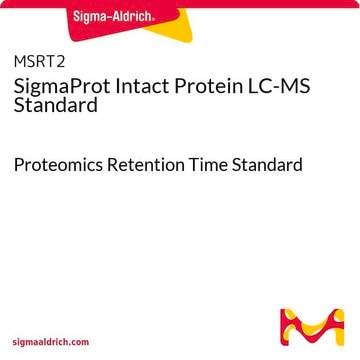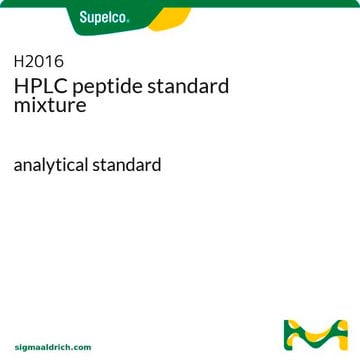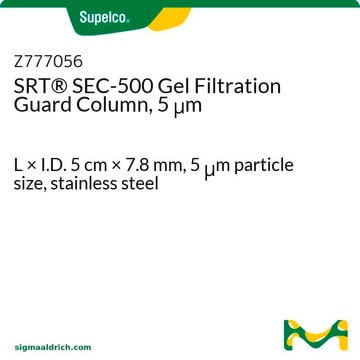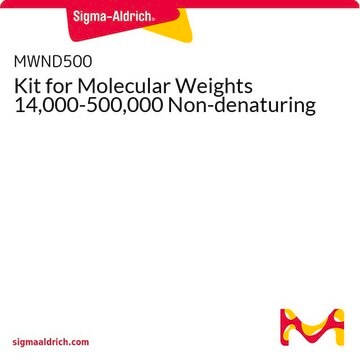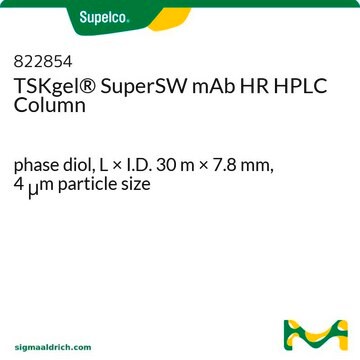69385
Protein Standard Mix 15 - 600 kDa
for size exclusion chromatography
Sign Into View Organizational & Contract Pricing
All Photos(1)
About This Item
UNSPSC Code:
85151701
NACRES:
NA.24
Recommended Products
Quality Level
form
solid
mol wt
15-600 kDa
analyte chemical class(es)
amino acids, peptides, proteins
technique(s)
gel permeation chromatography (GPC): suitable
application(s)
clinical
food and beverages
pharmaceutical
format
neat
storage temp.
−20°C
General description
The protein standard mix is a calibration standard to test and monitor performance of size exclusion chromatography (SEC) columns. It is a lyophilized mixture of molecular weight markers ranging from 15 kDa to 600 kDa.
Components
Thyroglobulin bovine MW ~ 670 000 Da
γ-globulins from bovine blood MW ~ 150 000 Da
Ovalbumin MW~ 44 300 Da
Ribonuclease A type I-A MW ~ 13 700 Da
p-aminobenzoic acid (pABA) MW ~ 137 Da
Components
Thyroglobulin bovine MW ~ 670 000 Da
γ-globulins from bovine blood MW ~ 150 000 Da
Ovalbumin MW~ 44 300 Da
Ribonuclease A type I-A MW ~ 13 700 Da
p-aminobenzoic acid (pABA) MW ~ 137 Da
Application
This analytical standard is used for the following:
- Evaluation of selectivity and separation efficiency of size exclusion chromatography (SEC) to separate intact proteins by varying flow rate, size of silica particles and pore sizes in the column
- Simultaneous determination of oligomerized and nitrated proteins by size exclusion chromatography-high performance liquid chromatography-diode array detection (SEC-HPLC-DAD)
- Molecular weight separation of proteins by size-exclusion chromatography, formed upon O3 and NO2 induced oxidation, nitration, and oligomerization of bovine serum albumin (BSA) as a model protein
- Estimation of molecular masses of two recombinant proteins— TNF fluorescent sensor (BTN-Kat) and fluorescent sensor-inhibitor (ITN-Kat), by size exclusion chromatography (SEC) to evaluate their ability of binding and neutralizing tumor necrosis factor (TNF) in vitro and further serving as imaging labels for non-invasive analysis
related product
Product No.
Description
Pricing
Signal Word
Danger
Hazard Statements
Precautionary Statements
Hazard Classifications
Acute Tox. 4 Dermal - Acute Tox. 4 Inhalation - Acute Tox. 4 Oral - Aquatic Chronic 3 - Resp. Sens. 1
Storage Class Code
11 - Combustible Solids
WGK
WGK 3
Flash Point(F)
Not applicable
Flash Point(C)
Not applicable
Choose from one of the most recent versions:
Already Own This Product?
Find documentation for the products that you have recently purchased in the Document Library.
Customers Also Viewed
Different Structural Conformers of Monomeric α-Synuclein Identified after Lyophilizing and Freezing.
Amberley D Stephens et al.
Analytical chemistry, 90(11), 6975-6983 (2018-05-12)
Understanding the mechanisms behind amyloid protein aggregation in diseases, such as Parkinson's and Alzheimer's disease, is often hampered by the reproducibility of in vitro assays. Yet, understanding the basic mechanisms of protein misfolding is essential for the development of novel
Robert C Monsen et al.
Nucleic acids research, 49(3), 1749-1768 (2021-01-21)
Human telomeres contain the repeat DNA sequence 5'-d(TTAGGG), with duplex regions that are several kilobases long terminating in a 3' single-stranded overhang. The structure of the single-stranded overhang is not known with certainty, with disparate models proposed in the literature.
Christopher J Kampf et al.
Environmental science & technology, 49(18), 10859-10866 (2015-08-20)
Air pollution is a potential driver for the increasing prevalence of allergic disease, and post-translational modification by air pollutants can enhance the allergenic potential of proteins. Here, the kinetics and mechanism of protein oligomerization upon ozone (O3) exposure were studied
Thomas Fricke et al.
Viruses, 14(3) (2022-03-27)
Kaposi's sarcoma herpesvirus (KSHV) is associated with a significant disease burden, in particular in Sub-Sahara Africa. A KSHV vaccine would be highly desirable, but the mechanisms underlying neutralizing antibody responses against KSHV remain largely unexplored. The complex made of glycoproteins
Marc D Zack et al.
Scientific reports, 7(1), 11112-11112 (2017-09-13)
In this work, we characterized 2 novel insecticidal proteins; Vip3Ab1 and Vip3Bc1. These proteins display unique insecticidal spectra and have differential rates of processing by lepidopteran digestive enzymes. Furthermore, we have found that both proteins exist as tetramers in their
Our team of scientists has experience in all areas of research including Life Science, Material Science, Chemical Synthesis, Chromatography, Analytical and many others.
Contact Technical Service